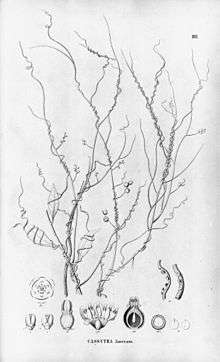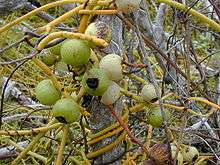Cassytha filiformis
Cassytha filiformis, common name love-vine, is a species of obligate parasitic vine in the family Lauraceae. The species has a native pantropical distribution encompassing the Americas, Indomalaya, Australasia, Polynesia and tropical Africa [2][3] In the Caribbean region, it is one of several plants known as "Love vine" because it has a reputation as an aphrodisiac.[4]
| Cassytha filiformis | |
|---|---|
 | |
| Scientific classification | |
| Kingdom: | Plantae |
| Clade: | Tracheophytes |
| Clade: | Angiosperms |
| Clade: | Magnoliids |
| Order: | Laurales |
| Family: | Lauraceae |
| Genus: | Cassytha |
| Species: | C. filiformis |
| Binomial name | |
| Cassytha filiformis | |
| SynonymsThe Plant List | |
| |
Cassytha filiformis is a twining vine with an orange to pale green stem. Leaves are reduced to scales about 1 mm long. Flowers are borne in spikes or sometimes solitary. There are six tepals, each 0.1-2.0 mm long. Fruit is a drupe about 7 mm in diameter.[2]
The 1889 book 'The Useful Native Plants of Australia records that the "This and other species of Cassytha are called " Dodder-laurel." The emphatic name of "Devil's guts" is largely used. It frequently connects bushes and trees by cords, and becomes a nuisance to the traveller. "This plant is used by the Brahmins of Southern India for seasoning their buttermilk. (Treasury of Botany?)".[5]
A 2018 study revealed how a southern Florida subspecies of this widespread species has developed a complex form of carnivorous plant behaviour. New tendrils will actively seek out galls made by the gall wasp, Belonocnema treatae, on leaves of a host oak tree, Quercus geminata. Once its haustoria -- the parasitic growth that infects its host -- penetrates the gall, the larvae shrivel as this parasitic plant drains both the gall and its inhabitant. In the study [6] , other species of plant and gall wasp become parasitised by this plant in the southern Florida area too.


References
- "Cassytha filiformis". Germplasm Resources Information Network (GRIN). Agricultural Research Service (ARS), United States Department of Agriculture (USDA). Retrieved 2013-01-28.
- Flora of North America vol 3
- D. S. Correll & M. C. Johnston. 1970. Manual of the Vascular Plants of Texas. University of Texas at Dallas.
- Esbaugh, W. Hardy; McClure, Susan A. & Bolyard, Judith L. Bush Medicine Studies, Andros Island, Bahamas. Proceedings of the first symposium on the botany of the Bahamas June 11–14, 1985. Ed. Robert R. Smith., San Salvador, Bahamas.
- J. H. Maiden (1889). The useful native plants of Australia : Including Tasmania. Turner and Henderson, Sydney.
- https://www.cell.com/current-biology/fulltext/S0960-9822(18)30815-7
External links
| Wikimedia Commons has media related to Cassytha filiformis. |
| Wikispecies has information related to Cassytha filiformis |
- Love Vine at Center for Aquatic and Invasive Plants, University of Florida
- https://www.cell.com/current-biology/fulltext/S0960-9822(18)30815-7